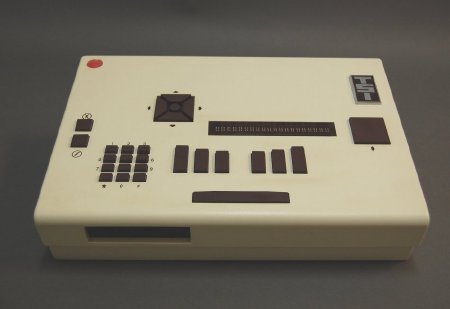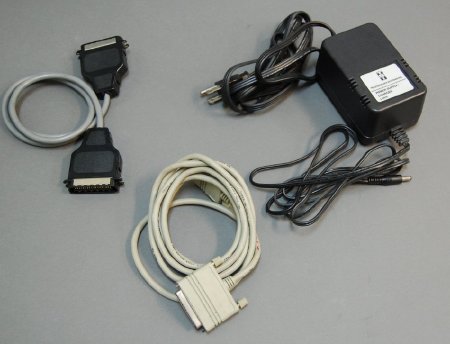Object ID:
2017.22.2
Title:
Versabraille II+ Portable Braille Computer
Creator:
Telesensory Systems, Inc.
Description:
(a) Rectilinear ivory aluminum chassis with rounded edges, rests on four black rubber feet that slightly angle the top towards the user; top has seven rectangular brown rubber keys, the six braille keys taller as you move from the center out on both sides, long space bar below; twelve key numeric keypad on left, slightly below separate on and off buttons and a brown rubber joystick pad; twenty key piezoelectric refreshabe braille display on brown bar above keyboard; aluminum "TSI" logo on cast plate in upper right; brown plastic carrying handle (which doubles as a keyboard stand) fold uner on bottom in back; 3.5" floppy disk drive in recess on front left; jack panel on back side of unit includes, from left to right, power supply jack, on/off slider switch, RS-232C-DTE and RS-232 DCE serial ports, external disk drive jack, and parallel printer jack; foil label on bottom, "Model No. VBII+ Serial No. L1C-005/Telesensory Systems Inc. Made in U.S.A."; (b) external power supply/charger, black plastic rectangular box with two cords emerging from opposite sides, one with male wall plug, the other with a female computer plug, labeled "Telesensory Systems Inc./L16016"; (c) Kaypro gray and black plastic parallel printer cable; (d) D-sub serial cable, eight pin DE-8 connector to DB-25.
Dimensions:
H-3.5 W-15.25 D-10.25 inches
Date:
ca. 1987
Made by:
Telesensory Systems Inc.
Place of Origin:
Mountain View, CA
Provenance:
When introduced by Telesensory in December 1979, the original Versabraille was the first refreshable braille device designed in the U.S. The II+ was an updated model that included an internal floppy disk (the original stored data on a cassette tape) and a surface mounted joystick.
In 1983, Howard and David Goldstein asked to be testers for Telesensory's Braille Information Process (BIP). Later they would edit a Versabraille newsletter, the Versa News. As a result, by 1984 they had been provided with a new II+ by Jim Bliss at Telesensory. They liked the internal disk drive, the parallel printing connectivity, its ability to work with the Duxbury braille software, and that the II+ was a servicable braille terminal for a desktop computer. And the II+ used menus, one of the first accessible computers to do so. But they also found that the proprietary II+ operating system was clumsy, the ergonomics of the keyboard caused wrist injuries and "we really didn't like it." They used the II+ into the early 1990s, when they moved first to an Ampro 4 and then to an IBM PC equipped with Powerbraille and Word Talk software.
In 1983, Howard and David Goldstein asked to be testers for Telesensory's Braille Information Process (BIP). Later they would edit a Versabraille newsletter, the Versa News. As a result, by 1984 they had been provided with a new II+ by Jim Bliss at Telesensory. They liked the internal disk drive, the parallel printing connectivity, its ability to work with the Duxbury braille software, and that the II+ was a servicable braille terminal for a desktop computer. And the II+ used menus, one of the first accessible computers to do so. But they also found that the proprietary II+ operating system was clumsy, the ergonomics of the keyboard caused wrist injuries and "we really didn't like it." They used the II+ into the early 1990s, when they moved first to an Ampro 4 and then to an IBM PC equipped with Powerbraille and Word Talk software.
Credit Line:
Gift of David Goldstein, 2017.22.

